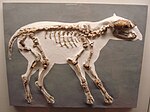The most recently active centre is the Gran Cratere at the top of the Fossa cone, the cone having grown in the Lentia Caldera in the middle of the island...
15 KB (1,672 words) - 04:50, 12 November 2024
but differs by its well-developed occipital crests and lack of preorbital fossa. The dentition of Amphimeryx suggests that it may have had a preference...
67 KB (7,120 words) - 14:15, 16 November 2024
anoplotheriines such as Anoplotherium, Catodontherium had a preorbital fossa. It also had cranial and dental morphologies typical of the Dacrytheriinae...
35 KB (3,582 words) - 12:32, 14 October 2024
Anoplotherium and Diplobune but differed from them by a deep preorbital fossa and a lacrimal fossa, the latter of which is where the genus name derives from. D....
75 KB (8,050 words) - 02:27, 3 November 2024
supraspinous fossa is broader than the infraspinous fossa, but camels have narrower scapulae, especially in distal (back) ends of the supraspinous fossa. The...
127 KB (14,021 words) - 14:17, 16 November 2024
Diplobune (category CS1 German-language sources (de))
the preceding Diplobune species. The radial fossa of the humerus is not as marked, but the coronoid fossa of the humerus is well-pronounced in comparison...
103 KB (11,975 words) - 14:16, 16 November 2024
Madagascar (redirect from République de Madagascar)
possibly the largest bird to ever exist, Aepyornis maximus), the giant fossa, and several species of Malagasy hippopotamus, which have since become extinct...
225 KB (21,026 words) - 16:41, 15 November 2024
Bibcode:2019AcGlS..93..251V. doi:10.1111/1755-6724.13820. S2CID 133900941. Morlo, M.; LeMaitre, A.; et al. (November 2019). "First record of the mustelid Trochictis (Carnivora...
23 KB (2,038 words) - 15:10, 17 November 2024
multiple noticeable fossae (hollowings in bones) such as the lacrimal fossa and malar fossa, which are all deep but individualized in form. It is uncertain...
67 KB (7,261 words) - 14:14, 16 November 2024
Bachitherium (category CS1 German-language sources (de))
bordered by the nasal, maxillary, frontal, and lacrimal bones. The lacrimal fossa appears to be absent from the skull, the lacrimal hole instead opening inside...
109 KB (11,551 words) - 14:16, 16 November 2024
notch that is always located in front of P2, the lack of any preorbital fossa and a thinner body of the mandible compared to that of Paloplotherium. Paloplotherium...
107 KB (12,127 words) - 15:20, 16 November 2024
297 (11): 1207–15. doi:10.1001/jama.297.11.1207. PMID 17374815. Brydøy M, Fosså SD, Dahl O, Bjøro T (2007). "Gonadal dysfunction and fertility problems...
155 KB (17,518 words) - 23:36, 26 October 2024
proportionally small and moderately compressed between the center of the mandibular fossa (a fissure in the tympanic bone) of the temporal bone and a thick tympanic...
58 KB (6,068 words) - 02:27, 3 November 2024
zygomatic arches are narrow and close to the cranial vault. The mandibular fossa appears flat and horizontal, with a small postglenoid process (or projection)...
72 KB (7,557 words) - 14:14, 16 November 2024
lateral pharynx. Between the arches lies a triangular space, the tonsillar fossa in which lies the palatine tonsil, another lymphoid organ. The external...
233 KB (24,397 words) - 10:16, 16 July 2024
Euarchonta: Using μCT scan data to understand and infer patterns of nasal fossa evolution in primates". Journal of Human Evolution. 132: 137–173. Bibcode:2019JHumE...
200 KB (22,825 words) - 02:28, 2 November 2024
Tunisian Patrimony (لمعهد الوطني للتراث), first as maître de recherches and later as directeur de recherches, working with excavations, restoration and...
33 KB (4,607 words) - 16:51, 11 November 2024
the cerebrum because the former's cavity is not as large as the cerebral fossa and lack of coverage by the neocortex. The cerebellum appears higher in...
86 KB (9,681 words) - 14:16, 16 November 2024
Ghaffar et al. (2019). A study evaluating the ability of the extinct giant fossa to hunt large lemurs is published by Meador et al. (2019). Description of...
329 KB (34,184 words) - 02:56, 16 November 2024















